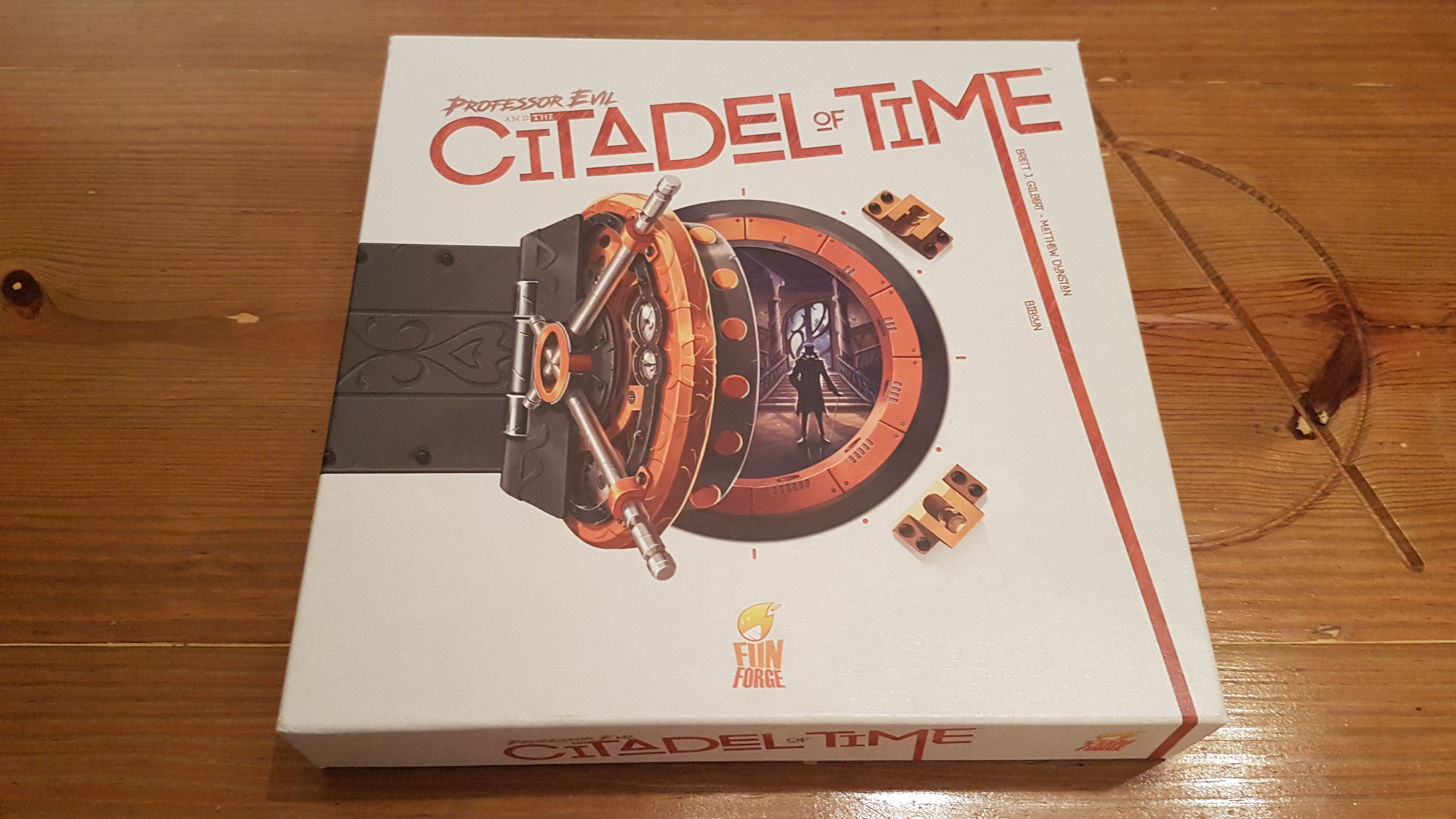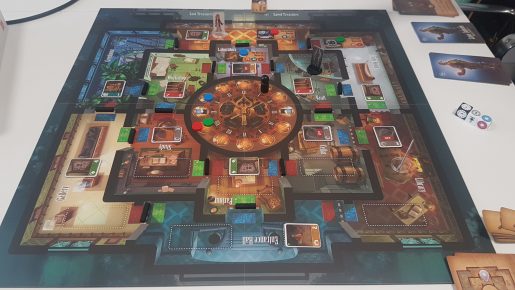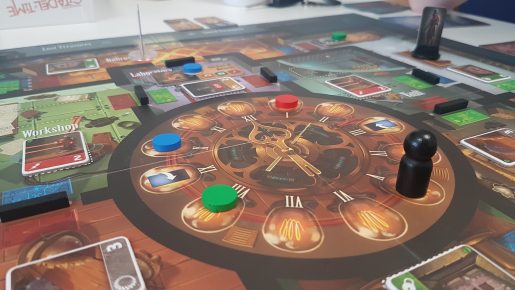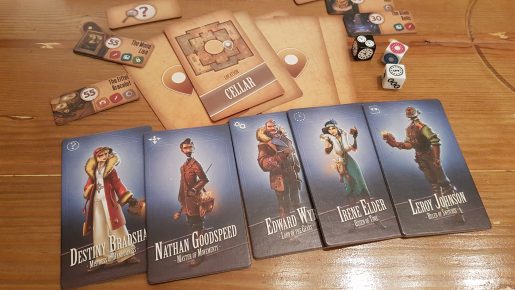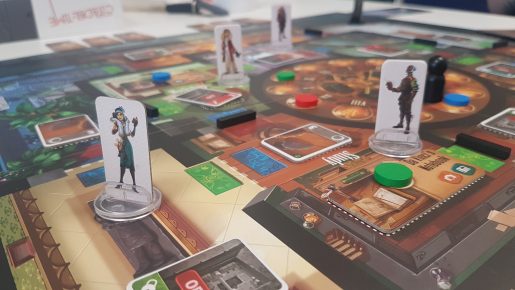Professor Evil and the Citadel of Time, apart from an extremely long name, is the brand new cooperative board game from Funforge. Designed by Matthew Dunstan and Brett J. Gilbert, the game sees 2 – 4 players spend action points and utilize variable player powers, all to gain glorious treasures – such as the Rosetta Stone. The reason behind the heist is that Professor Evil has been using his time machine to steal treasures. However, is recovering items as fun? Let’s find out!
During setup Professor Evil starts out in his laboratory with all of his mansion doors locked, though the windows are irresponsibly left wide open. Via shuffling the room cards and trap tiles, the 12 trap tiles are distributed one to each room; with the first 6 off (deactivated) and the latter 6 on (active). The first 3 treasures are then, again via the room deck, added to the board. Each treasure comes with two important attributes.
First, is a time in minutes that players have to rescue the treasure in. This time ranges from 30 to 55 minutes and is represented by playing a coloured token onto the treasure and a matching colour token onto the time tracker. At the start of the game the professor’s clock marker starts on the hour, so a 30-minute treasure would have the colour token placed at 6 o’clock. This shows players approximately how many turns they will have to rescue the treasure before Professor Evil locks it away for good, however it isn’t just a case of getting to each treasure. Individual treasures will require different sets of traps to be deactivated before it can be reclaimed.
On a turn players get 3 action points which they can spend to: move into the mansion via a window, move through an opened door into an adjacent room, unlock a door, deactivate a trap or rescue a treasure. A player can do any action, in any order, as many times as they wish. On top of these basic actions each turn a player draws their top 2 character power cards and gets to play one of them. These are strong abilities such as deactivating a trap in a room adjacent to the professor’s location, or gambling by rolling the colour dice to determine if it is a beneficial outcome or the professor’s turn is worsened. Each character has a different trend to their cards, though they are often extremely helpful!
So, you’ve done all of your basic actions and the special card action, therefore it is now the professor’s turn. He is controlled by three dice which the active player rolls. The clock dice determines how many times the professor’s clock marker moves clockwise around the time track. If at any point of the professor’s clock marker reaches or passes the colour token of a treasure it is lost. The other two dice, the colour die and professor die, combine to reveal what happens. This can see the professor walking from room to room, using the colour doormats based on the colour die, to using a secret passage to instantly travel to a specific treasure. This is never good for players, as any doors Professor Evil passes through are locked, any traps he encounters are re-activated and if he catches one of the team they are sent packing from the mansion.
As you might guess from the Citadel of Time part of the game’s title, players are to some extent against the clock. The team must rescue 4 treasures before Professor Evil secures 4 to win the game. To help players out there are, in addition to the normal cards, unique character abilities that can be gained. Whenever the professor’s clock marker reaches or passes the 3 and 9 o’clock spaces on the clock face one team member can flip their character tile, to reveal an ongoing effect and a one-time use ability. Being able to use these consistently would make Professor Evil and the Citadel of Time gamebreakingly easy so it’s good these come infrequently in terms of balance and challenge. For example, Leroy can go into a room with Professor Evil and be completely unaffected, something that can be key to victory if the professor is standing on that single trap you need to deactivate.
One thing that the mansion design has going for it is that the locations on the board are rather reminiscent of the Cluedo (Clue) board. With locations like the Ball Room and the Study it has been interesting to see newer gamers drawing comparisons, feeling less alienated by the new game in front of them as a result. For this reason, I feel Professor Evil and the Citadel of Time would be great for introducing someone to the hobby or even for families to play.
This idea of the title’s intended audience is strengthened by how the game works. Taking minutes to setup and teach, players won’t be bamboozled by a long list of actions or rules, enabling players to get straight into the action. Regrettably, the cards do take a little time for non-hobby gamers to get to grips with, each offering a unique power. This slight issue is exaggerated on the first few turns as new players can struggle to determine what is more beneficial. Unfortunately, this opens the door for cooperative quarterbacking.
By this I mean that one player can often muscle through to the front of the party and start to dictate who other players do on their turns. Timid, or introverted players, will feel a little forced and this can lead to the feeling of having little impact on the outcome of a game. Especially with new players, whom question what to do, it is often hard to force yourself into taking a backseat and letting them decide. As a result of specific options often being most beneficial, at least to those with only a few rounds experience, players can worry they are doing the wrong thing, yet this learning is part of the fun.
A game of Professor Evil and the Citadel of Time can be won or lost on the dice rolls but this isn’t to say that players’ choices don’t matter at all. It is more that the dice can dramatically shift the game out of reach from being achievable or making it an easy breeze. On a turn for instance a player might have deactivated the final trap needed to rescue a treasure, only for the professor to move into that room, lock the door, re-activate the trap and send the player instantly outside: it’s sometimes about pushing your luck while trying to be overly efficient. The randomness can also make players misinterpret how a game is going. A few times we have stormed into an early lead against the professor, claiming 2 treasures before he’s saved one, only for the tides to be turned and him win 4 – 3.
Overall, Professor Evil and the Citadel of Time has the same problem that a lot of cooperative titles struggle to surpass, the rise of quarterbacking. Until everyone is up to speed it naturally seeps into the gameplay and you’ll need to encourage players to make the decisions. Past this there is plenty of fun to be had, planning out as a team what to do and then hoping that it works out. There is a slight plot hole thematically about stealing from a man with a time machine but given the light heartedness of the game and the intended audience it can be overlooked.
The dice can at times be punishing and at others make things a lot easier, so if randomness isn’t your cup of tea stay away from the professors mansion. However, if for 30 minutes you don’t mind the dice influencing the outcome it certainly adds some tension at the end of each turn. Professor Evil and the Citadel of Time won’t be hitting the table over the likes of Pandemic but as a cooperative game it does offer an exciting experience that is a little different.
[Editor’s Note: Professor Evil and the Citadel of Time was provided to us, for the review, by Funforge.]

